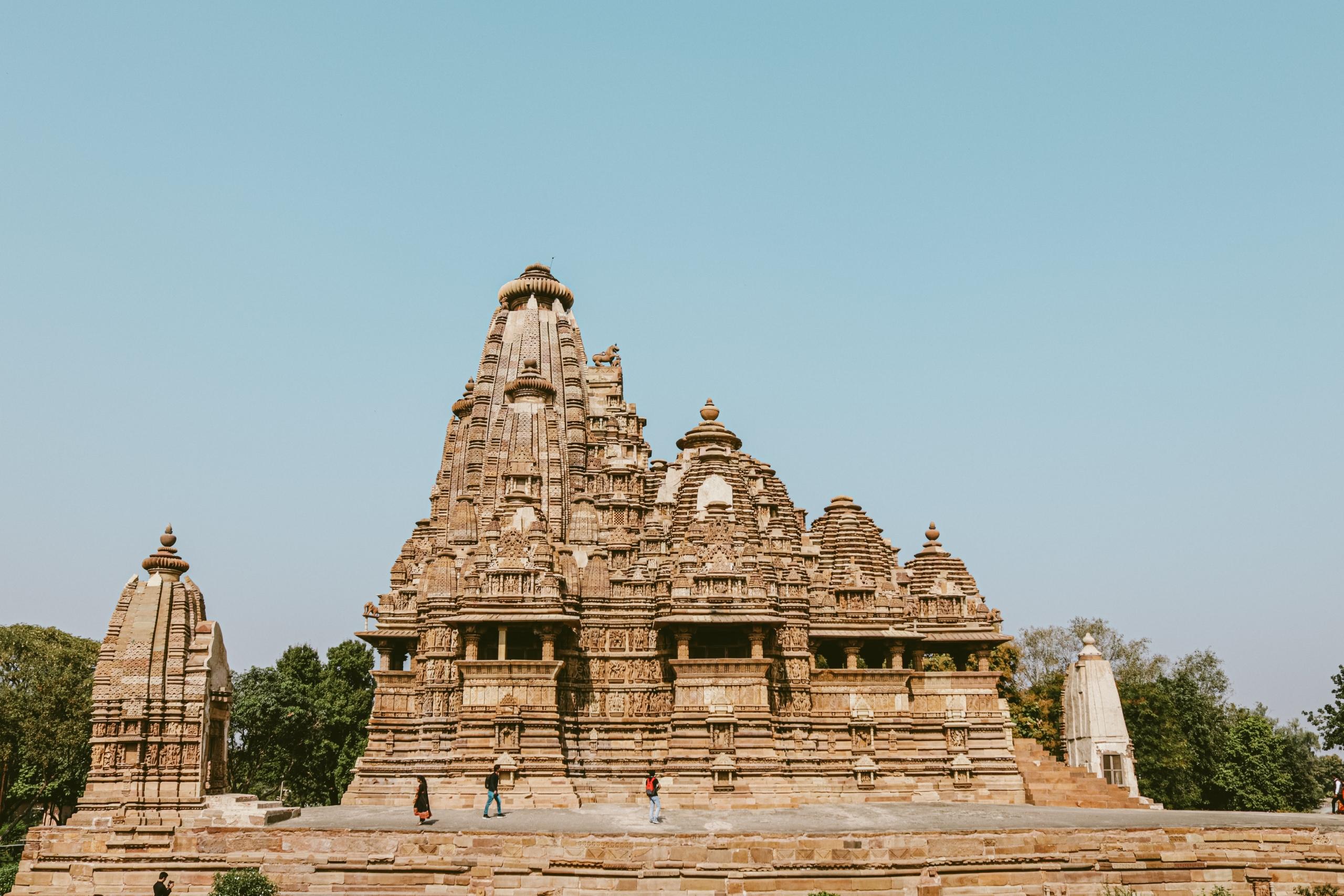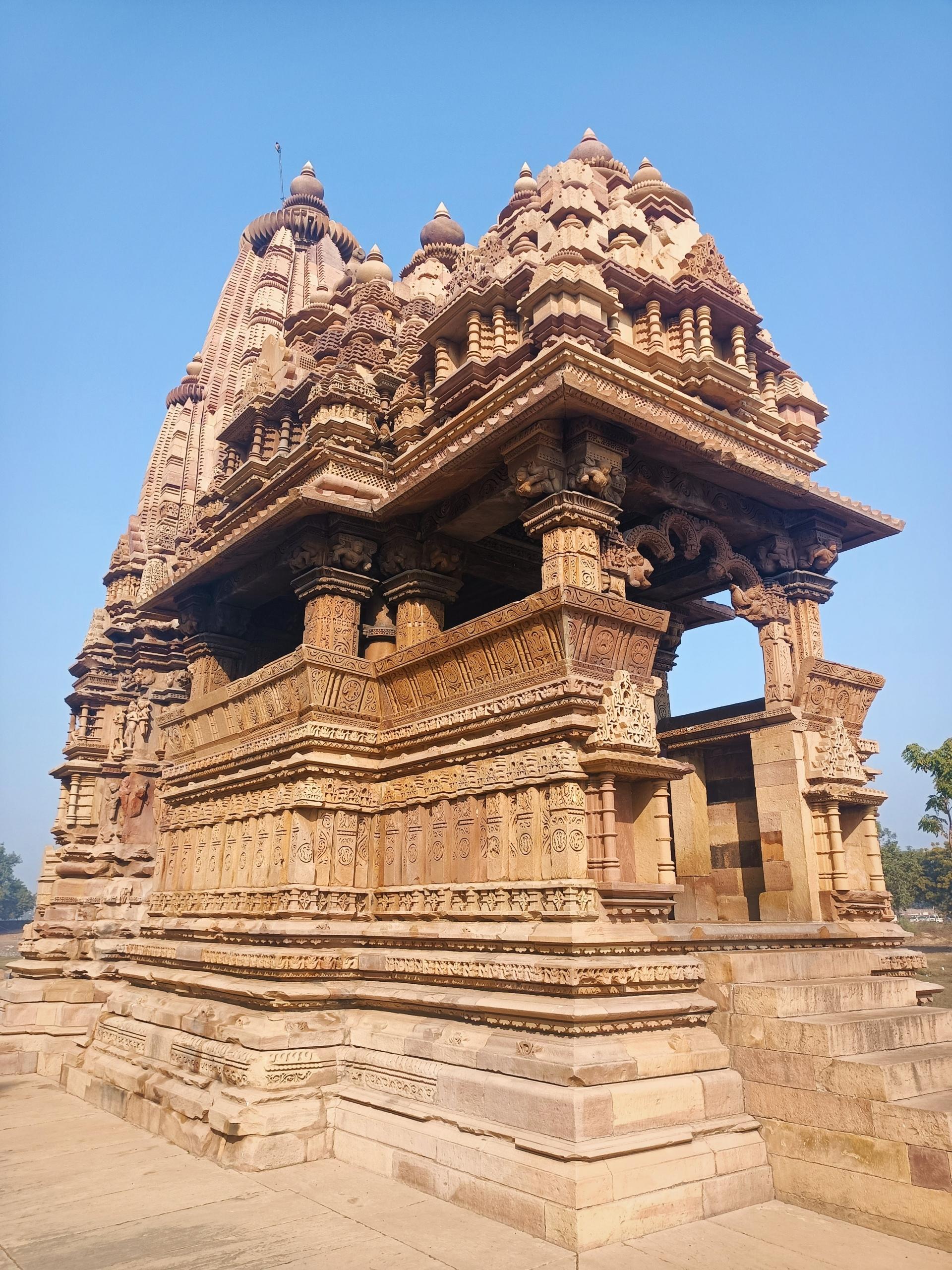The city of Khajuraho was once a bustling cultural and religious center and was even the capital during the reign of the Chandella dynasty for a short time.
It was clearly a city made for a specific purpose, marked by the prolific amount of intricate and beautiful temples, covered in art on all surfaces.
The history of the city and the monuments inside is long and fascinating. Let’s dive into the significance of the incredible Khajuraho Mandir!

The Beginnings of Khajuraho
Before the development of the city of Khajuraho, the dynasty known as the Chandellas had to be formed.
The Chandellas
The exact origins of the Chandellas are debated among historical scholars.
The Chandella people were an Indian Rajput clan located in Central India, for certain. They can trace their origins back to a city called Maniyagarh, named for Goddess Maniya Devi, who was historically worshipped by the Chandellas.
Some legends say they are the descendants of a union between the moon (Chandra) and Hemavati, who was the widowed daughter of Hemaraja, the priest of the king on Kashi, King Indrajit.

Other inscriptions say Nannuka, who was the first king in the newly-formed Chandella dynasty, was a descendent of sage Chandratreya, who was the son of Vedic sage Atri. Nannuka founded the Chandella dynasty in 835 CE, but it wasn’t an independent clan just yet.
For a long time, the Chandellas were subordinate to the Pratihara, but in the 9th century, the Chandellas broke free and declared themselves an independent dynasty.
This is when, in 885, the 5th ruler of the Dynasty, Rahila, liberated the Chandellas and created an independent people.
Expanding the Kingdom
After Nannuka established his kingship, he and his people worked hard to extricate themselves from the rule of the Pratihara, the dynasty that was currently ruling.
Nannuka’s descendants (his son, his son’s son, and so on) consistently fought against the Gujara-Pratihara and sought to expand Chandella’s control.
Eventually, the dynasty controlled a large realm known as Jejakabhukti (Jijhoti) and was able to be self-sufficient and focus on other things besides defending against the Gujara-Pratiharas. The Chandellas gained more territory and cultivated their own way of life inside the dynasty.
The cultural and religious capital of the dynasty was Khajuarho, but since the Chandellas wanted to keep religion and politics separate, the political capital of Mahoba was also established.
The Utopian City of Khajuarho
Located in what is now the Chhatarpur district of Madhya Pradesh, ancient Khajuraho was first occupied by the Mauryans (322 BCE), the Sungas, the Kushans, the Nagas of Padmavati, the Vakataka dynasty, the Guptas, the Pushyabhuti dynasty, and then the Gujara-Pratiharas before becoming a city under the Chandella dynasty. The land was known as being part of the Bundelkhand region.
So, it was already developed to some extent and had an architecture that was already considered quite old by the people who lived there.
When the Chandellas became a dominant dynasty, they started building new temples and monuments in Khajuraho.
The medieval city of Khajuraho saw the construction of dozens of religious temples and perhaps other intricate yet mundane buildings since it was a functioning city, not just a religious hub.
The tradition of building intricate temples in Khajuraho likely began during Yashovarman's reign (c. 925 - 950 CE) when he commissioned the Lakshmana Temple.
Most of the temples are believed to have been built between 950 and 1050 CE, but construction of the temples was likely happening from about 885 to 1125 CE. It’s believed that every king of the Chandellas (of which there were 19 who strongly ruled over Khajuraho) had a social duty to construct at least 1 temple in their lifetime or period of rule.
The temples show that the society here was likely much more tolerant and open than we tend to believe older civilizations were. They may have even been more accepting of others than general society is today!
Many of the temples are built for Hindus, but there are many Jain temples as well, showing that the two sects of people respected each other highly. There is even a surviving Buddhist statue that was found among the Jain and Hindu temples! Additionally, the carvings of the temples show a more liberated society in terms of the human experience, since they depict all sorts of human activity including erotic acts.
Surviving Destruction Through Obscurity
How have the temples survived this long, especially considering the invasion of the Muslims in the 14th century? A long chain of events had to occur to keep that kept the surviving temples safe.
The Decline of the Chandella Dynasty
By the end of King Vidyadhara of the Chandella’s reign (1003 - 1035 CE), enemies had begun weakening the dynasty and the surrounding clans as well. In 1022, Chandella had its first serious attack from Mahmud of Ghazni, when Kalinjar was raided.
The next handful of kings dealt with a lot of back-and-forth fighting, losing, winning, taking territory, losing territory, gaining allies, and losing allies.
For a long time, the Chandella dynasty was locked in a continuous power struggle to hold onto what they already had. King Paramardi (1165 - 1203 CE) was the last strong ruler of the Chandella dynasty.

In 1203, Qutb al-Din Aibak of Dehli and the Ghurid Empire invaded the Chandella kingdom and greatly weakened it. History says that Paramardi surrendered, and the power of his dynasty was decreased to be beneath Delhi.
The attacks from the Muslim forces each damaged the temples since the Muslim people did not tolerate any idols other than their own.
Chandellan activities were relocated to other cities and the importance of Khajuraho was reduced greatly; it was no longer a large city.
A few more Chandella leaders came after this surrender, but each had less power than the last. In 1315, the 24th and final ruler, Viravarman, is recorded as being reduced to a local chief.
How Obscurity Saved the Temples
Since the last of the Chandellans moved their operations to other cities, hardly anyone - including attacking forces - had any reason to travel all the way to Khajuraho, which was very remote and isolated.
The temples did suffer another raid in 1495 CE when Sikandar Lodi led a campaign to destroy temples, but other than that, the city was mostly left alone.
The people who lived there intentionally stayed quiet and out of the way to avoid attention from forces who would continue to destroy the temples further.
Simply put, the temples that survived did so because those who would destroy them essentially forgot they existed. They were out of sight, out of mind.

Why Are the Monuments of Khajuraho Popular Today?
The locals of the time as well as travelers have always been in awe of the architecture built up around Khajuraho. The first mention of the monuments in history is from Abu Rihan al Biruni in 1022 CE, who was the Persian historian accompanying Mahmud of Ghazni in his raid of Kalinjar.
Another historical mention is made by an Arab traveller In Battuta in 1335 CE after some attacks had already been made on the temples.
“...near (Khajuraho) temples, which contain idols that have been mutilated by the Moslems, live a number of yogis whose matted locks have grown as long as their bodies. And on account of extreme asceticism they are all yellow in colour. Many Moslems attend these men in order to take lessons (yoga) from them." — Ibn Battuta, about 1335 CE, Riḥlat Ibn Baṭūṭah, Translated by Arthur Cotterell
Presumably, locals in the area never forgot about the city, but the rest of the world had forgotten.
The city was brought to the world’s attention in 1838 when local Hindus guided T.S. Burt, a British surveyor, to the temples and he reported them. But, interest in the temples wasn’t piqued by the world until a few years later when Alexander Cunningham reported that the city was still secretly in use by Hindus and yogis who would take pilgrimage during Shivaratri.
Drawings of the temples were made in 1852 by F.C. Maisey.
Lost City of Incredible Architecture
Because of how many temples survived through time, and are still in exemplary condition today, and the content and quality of the carvings, the monuments in Khajuraho are considered one of the “seven wonders” of India.
It was also listed as a UNESCO World Heritage Site in 1986.
It appears that not only did the kings of the Chandella dynasty commission temples, but locals had been building them and continued to do so before and during their rule.
In total, there are 85 known temples that make up the Khajuraho monuments, but only 22 (plus one partially excavated one) survived to the present. The temples are all located in an area of about 6 square km.
| Temple Name | Reigion | Deity | Year Completed (CE) |
|---|---|---|---|
| Chausath Yogini | Hinduism | Devi, 64 Yoginis | 885 |
| Lalguan Mahadev | Hinduism | Shiva | 900 |
| Brahma Temple | Hinduism | Shiva | 925 |
| Lakshmana | Hinduism | Vaikuntha Vishnu | 939 |
| Varaha | Hinduism | Varaha | 950 |
| Parshvanatha | Jainism | Parshvanatha | 954 |
| Ghantai | Jainism | Adinatha | 960 |
| Mahishasuramardini | Hinduism | Parvati | 995 |
| Vishvanatha | Hinduism | Shiva | 999 |
| Matangeshwar | Hinduism | Shiva | 1000 |
| Vishnu-Garuda | Hinduism | Vishnu | 1000 |
| Beejamandal Temple ruins | Hinduism | Shiva | 1000 |
| Ganesha | Hinduism | Shiva | 1000 |
| Jagadambi | Hinduism | Devi Jagadambi | 1023 |
| Chitragupta | Hinduism | Chitragupta | 1023 |
| Adinath Temple | Jainism | Adinatha | 1027 |
| Shantinatha temple | Jainism | Shantinatha | 1027 |
| Kandariya Mahadeva (the largest temple) | Hinduism | Shiva | 1029 |
| Vamana | Hinduism | Vamana | 1062 |
| Javeri | Hinduism | Shiva | 1090 |
| Chaturbhuja | Hinduism | Vishnu | 1110 |
| Duladeo (Duladeva) | Hinduism | Shiva | 1125 |
Intricate Carvings
While the Khajuraho temples are most well-known for their erotic carvings, such carvings only make up about 10% of all the sculptures found in all the temples combined. The erotic carvings are included with depictions of everyday human life, so one must look hard or be shown by a tour guide where to find the erotic forms.
The carvings seem to indicate the values that are important in the Hindu pantheon, like Avyakta, Vyaktavyakta, and Vyakta of the Āgamas.
There are other arts to be found in the temples as well, like spires, Linghams, sculptures, and scriptures.
The most visited temple is Kandariya Mahadev, which is enormous, taking up about 6,500 square ft. (604 square meters). Its spire (shikhara) reaches 116 ft (35.3 m) into the air.
Heritage for Hindus and Jains
For Jains and Hindus, Khajuraho is a place full of ancient heritage. (And even Buddhists can see an ancient Buddhist sculpture here.)
Matangeshvara temple is currently still used for worship and it’s possible to observe all the major Hindu holy days. It is especially used to celebrate Shivaratri, which is observed as an extremely popular dance festival.
The Hindu temples all belong to Shaivaism and Vishnuism.
34 of the known temples fall into the Jain category. The most well-known of the Jain temples here are Parshvanath Temple, Ghantai Temple, and Adinath Temple. One temple, Shantinath Temple, was constructed from the ruins of other temples during the colonial era.
How to Visit Khajuraho
Since Khajuraho is now a tourism hotspot, it is no longer an isolated, hidden jungle clearing. In fact, it’s been made rather easy to travel to this incredible heritage site.
Travelling to the City
It’s possible to visit the city by car, but many people opt to travel to the Jhansi Railway Station, Katni South Station, or Satna Railway Station and hire a taxi or car to take them into Khajuraho. There is also a direct train between Khajuraho and Varanasi.

Fortunately, Khajuraho has its own airport! Currently, you can take a flight from Delhi or Varanasi directly to Khajuraho Airport. The other airport option is Jabalpur Airport. Taxis are available to and from both of these airports.
When to Visit Khajuraho
Khajuraho is open year-round for tourism, and you may explore the city from sunrise to sunset.
It’s recommended to visit between October to March, since that’s when all the other nearby attractions are also open, like the Panna Tiger Reserve, Orchha, Jhansi, Chanderi, and Dhubela.
In the winter, there are also a lot of festivities to attend in the city, like Dussehra, Diwali, Holi, Christmas, and the New Year. At the end of February, there is also the annual, internationally-recognized Khajuraho dance festival, which is so popular that it’s wise to book accommodations during this time well in advance.
How Much Do Guides Charge In Khajuraho?
The charges for guides in Khajuraho can vary depending on the duration of the tour and the guide's expertise. On average, the cost for a guide for a half-day tour starts from around INR 500 to INR 1000, while a full-day tour can cost between INR 1000 to INR 2000.
What Should I Wear In Khajuraho?
There is no strict dress code when visiting the temples, however, you must remove your shoes when entering a temple. So, it’s recommended to wear comfortable shoes that are easy to slip on and off.
It’s also a good idea to wear clothing that covers down to the elbow and knees as a way to respect the religious significance of the temples.
You should also keep the climate in mind when dressing, as it does get very hot and humid in this region for much of the year.
There are three groupings of the temples: the Western Group, the Eastern Group, and the Southern Group. Most of the temples are in the Western Group, but all groups are worth seeing.
Khajuraho Dance Festival
The Khajuraho Dance Festival takes place annually during the last week of February. It is a popular attraction for tourists, who come from various countries specifically to witness this festival. The event showcases the best classical dancers from all over India, who perform in the open-air corridors of the Khajuraho group of temples. Visitors can enjoy a variety of traditional Indian dances, including Kathak, Bharatnatyam, Kuchipudi, Odissi, Manipuri, and more.
The Tourism Board of Madhya Pradesh organizes and promotes this cultural event, providing a platform for young dancers to showcase their talent to visitors from around the world. The festival takes place in front of the Chitragupta and Vishwanath temples, which are located in the western group of the temple complex. This event is highly regarded by enthusiasts of traditional Asian performing arts.
Admission to the dance festival is free.
There is also typically a nightly light and sound show which is narrated by Bollywood star Amitabh Bachchan(recorded), which is also free to attend.
References
- Desai, Dr Devangana. “The Buddha Image at Khajuraho and Its Significance.” The Complex Heritage of Early India, Essays in Memory of R.S. Sharma, 1 Jan. 2014, www.academia.edu/34913025/The_Buddha_image_at_Khajuraho_and_its_Significance.
- “Khajuraho Group of Monuments.” Wikipedia, Wikimedia Foundation, 19 Nov. 2023, en.wikipedia.org/wiki/Khajuraho_Group_of_Monuments.
- Www.khajuraho-India.org. “Khajuraho Temples Tourism. Explore Khajuraho, Panna, Orchha, Gwalior, Chanderi in Madhya Pradesh.” Khajuraho Temples, www.khajuraho-india.org/. Accessed 27 Nov. 2023.















